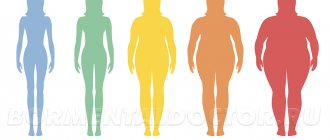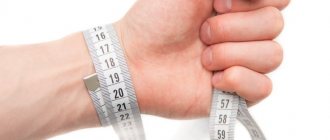A person’s normal weight is that body weight at which he has the maximum chance of first of all being healthy, and secondly of being attractive in appearance. Compliance with normal indicators does not provide a 100% guarantee of health, but it reduces the risk of diseases and disorders, the risk factor of which is excess body weight. Statistically, those who maintain a normal weight for their height and age feel good even after intense training.
How to calculate normal weight
In reality, optimal weight is an abstract concept that means a certain average value obtained in a calculation that takes into account the physiological parameters of a person:
- height;
- age;
- gender;
- body features.
But when calculating normal weight, individual indicators are not taken into account:
- level of physical activity;
- muscle-fat ratio.
Therefore, the value obtained from the formulas cannot be called as accurate as possible. It is only an approximate guideline that is recommended to be used when monitoring body weight.
The most accurate boundaries of normal weight are considered to be the interval from the minimum to the maximum value, which, according to doctors, a person’s body weight should fall within.
There are several ways to determine normal weight:
- by height;
- by height and age;
- by BMI (body mass index).
Why do you need to know your BMI?
Data from the World Health Organization indicate that obesity is currently one of the leading diseases in the world. Doctors successfully fight various kinds of pathologies, infections, and diseases. But the fight against excess weight has not yet shown good results. This is due to an incorrect lifestyle, an abundance of fast food, fatty foods. The consequences of obesity and excess weight are terrifying - type 2 diabetes, a tendency to heart attacks, disruption of the functioning of internal organs.
Body mass index may indicate problems occurring in the body:
- an increased value indicates the risk of serious diseases associated with excess weight: hypertension, diabetes, varicose veins, problems of the cardiovascular, digestive systems, internal organs;
- a reduced value is a signal of exhaustion, possible deficiencies of vitamins, minerals, and nutrients. A weakened body is less resistant to external influences. There is a decrease in local immunity and protective reactions. A lack of fat mass and a low BMI may indicate type 1 diabetes, osteoporosis, digestive disorders, mental problems, and eating disorders.
Calculation by height
The method of calculating normal weight by height is better known as Broca's formula, a French anthropologist. It is the most popular because it is the simplest of all. The formula is considered to be suitable for calculating normal body weight in people with a height of 155 to 185 cm.
How to calculate normal weight taking into account height using the formulas:
- For men: height (cm) - 110.
- For women: height (cm) - 100.
For example, a man’s height is 185 cm. In this case, the norm for him will be considered 185 - 110 = 75 kg. For a woman with a height of 165 cm, a healthy body weight will be 165 - 100 = 65 kg.
We advise you to study: “Why do girls need protein.”
When calculating using these formulas, the following must be taken into account:
- For people 20-30 years old, the calculated value should be reduced by 11%, and for those over 50 years old, it should be increased by 6%.
- Body type. It can be asthenic, normosthenic and hypersthenic. For asthenic, it is necessary to reduce the calculated norm by 10%, and for hypersthenic, on the contrary, increase by 10%.
The criterion for determining body type is the circumference of the wrist of the working hand:
- Asthenic: in women - less than 16 cm, in men - less than 17 cm.
- Normosthenic: in women - 16-18 cm, in men - 17-20 cm.
- Hypersthenic: in women - more than 18 cm, in men - more than 20 cm.
Lorentz formula
There is another way to calculate the normal weight of a woman or man, which takes into account only height. Here the calculation is carried out using the Lorentz formula:
Weight (kg) = (Height (cm) - 100) - (Height (cm) - 150)/2.
For example, for a man 190 cm tall the following are optimal:
(190 - 100) - (190 - 150)/2 = 70 kg.
Height to weight ratio in men
The normal weight and height for men depends on many factors. Firstly, this is directly influenced by heredity, that is, what was inherited from the genetics of the parents. Secondly, composition, nutritional standards, and lifestyle also play a primary role in the correct ratio.
When understanding what correspondence between height and weight in men can be considered correct, we must not forget about the accompanying factors. To do this, you will have to evaluate the degree of physical activity, professional work activity, the specifics of the physique itself, previous diseases and age. Each of the presented indicators needs to be studied and carefully considered in order to get the correct overall picture.
Golden ratio: why know the correct proportions
Only after taking into account all the indicators can you try to derive a formula for the ideal ratio of weight and height for men. Based on such factors, specialists can make a completely appropriate conclusion. But how is everything calculated? Experts usually take a person’s height, weight, chest volume, and bone severity. Moreover, for a healthy adult guy, usually this ratio (height/weight) should remain unchanged throughout the entire time. That is, it should not depend on any external factors.
If the indicator constantly increases, then most likely this indicates weight gain, which ultimately threatens obesity. However, if the number decreases, then this also does not bode well. Loss of weight for no apparent reason can indicate inflammatory processes in the body and the development of diseases. This will allow you to identify problems early so that you can carry out a full examination and begin treatment before things go too far.
Body types: brief description
In the scientific literature you can find a lot of information and references to a person’s somatotype (body type). According to this theory, all body build options can be divided into three main types, which we will now discuss in more detail.
Most people today, as well as online resources, fitness groups and communities, adhere to this system of physique assessment. However, few people know that back in the seventies of the twentieth century, the inconsistency of such a view was recognized by almost the entire scientific community. This happened for a reason, but because in most cases the body shape is combined, and does not fully correspond to all the characteristics of a particular somatotype. The world-famous scientist William Sheldon, the author of a work on temperament (constitution), says that pure body types are actually extremely rare. At the same time, he claims that in almost any person one can find at least minimal signs of the other two somatotypes.
Endomorph
In another way, this body structure can be called hypersthenic. Purely visually, you will never confuse an endomorph with any other group. It is these men who are prone to the accumulation of subcutaneous fat. It is rare that the bone structure of this type of person is thin, small or normal. Usually this is a large-boned skeleton with massive limbs.
At the same time, the arms and legs are not particularly long, which gives such people a squat, stocky appearance even with a small body weight. Guys of this type have a larger waist and hips than others, and all this is supported by serious accumulations of visceral fat in the abdominal area with an incorrect attitude towards body culture.
Ectomorph
This is the complete opposite of the endomorphic type or asthenic body structure. These guys have extremely low body fat levels. This statement is true for both subcutaneous and visceral fat. Usually these are thin people with an elongated figure, thin shoulders that are not broad, and thin limbs. The chest of such guys is poorly developed, it is flat and fragile.
The arms and legs of the ectomorphic somatotype are thin and rather long. At the same time, in sports these types cannot boast of high performance and results. But they have much more developed endurance, and sometimes even agility. Therefore, athletes of this type can show very good results in fitness, athletics and other similar disciplines. Hyposthenics have an accelerated metabolism, which makes it difficult for them to gain muscle mass. This is facilitated by low levels of glycogen in the muscles.
Mesomorph
There are people with an innate propensity for various sports, who are classified as a normosthenic type of build. They are distinguished by an increased level of the male hormone testosterone, and at the same time by a pronounced masculinity (lush facial hair, low voice). Typically, such men have a good appetite and a fast metabolism, which together makes it possible to increase muscle mass at an emergency pace without any obstacles if necessary.
Normosthenic men, for all their muscle mass, usually have minimal subcutaneous and visceral fat deposits. Almost every representative of mesomorphs has a well-developed chest, broad shoulders, and proportional limbs. Their muscle structure is long and wide. Most professional athletes belong to this somatotype.
Classification of body types according to the Solovyov index for men
The weight and height index for men can be determined using Dr. Solovyov’s algorithm. It is not complicated at all, just measure the circumference of your wrist at the thinnest point. The indicators must be indicated in centimeters; they are the index itself, which must then be checked against the presented values.
- Thin-boned or asthenic somatotype - less than 18 centimeters.
- Broad-boned or hypersthenic type - more than 20 centimeters.
- Normal somatotype is 18-20 centimeters.
The second calculation option using the Solovyov index is based on calculating the edge angle. It can be determined using a protractor or by eye, if you can trust yourself. To do this, stand in front of a mirror with your back straight. Place the ribs of both palms on the solar plexus under the chest so that the hands follow the branching of the ribs. It is the angle between the palms that will also be the Solovevo index, which determines the somatotype.
- Asthenics are characterized by an acute angle.
- Hypersthenia implies an obtuse angle.
- In a normal physique, the angle most often has 90 degrees or values as close as possible to this figure.
Carrying out such measurements is not difficult, so even a beginner can cope with the task.
The effect of age on weight
Few people understand that correct calculation of a man’s weight by height and age is only possible if all indicators are taken into account. It is important that the number of years a person has lived must be taken into account. Typically, strong young people are taller than older people, so normal body weight will not be the same for them.
Calculation of normal body weight by age and height
As such, there is no formula for normal weight depending on age and height. Here we are talking about a table of ready-made values. It indicates height, age and gender. It is enough to first find your height, then your age and gender, and find the value at the intersection of the required row and column. This will be your optimal body weight. The table below shows the normal weight of a person by age and height.
This formula can be used to calculate weight for most people, except:
- professional athletes;
- pregnant women;
- people suffering from edema and other disorders that lead to excess weight.
Calculation by body mass index
Another popular way to determine a person’s normal weight requires calculating the body mass index (BMI). But this technique is designed a little differently - it does not calculate a specific value of body weight, but determines whether it corresponds to the norm. BMI allows you to assess whether your body weight is overweight, normal or underweight.
The formula for calculating normal weight here is as follows:
BMI = Weight (kg)/Height2 (m).
With a weight of 75 kg and a height of 180 cm, the BMI will be 75/1.8 · 1.8 = 23.15.
The number obtained by the formula remains to be compared with the following values:
- less than 15 - acute lack of weight;
- 15-20 - underweight;
- 20-25 - normal weight;
- 25-30 - overweight;
- 30-35 - 1st degree obesity;
- 35-40 - 2nd degree obesity;
- more than 40 - third degree obesity.
We advise you to study: “Top 5 protein bars for weight loss.”
The optimal weight is considered to be one that corresponds to a BMI of 23. It is the calculation based on body mass index that is the most accurate today. It is designed for ordinary people, taking into account modern living conditions, medical advances and the latest observations. The BMI method is also recommended by WHO.
But the calculated value again turns out to be averaged. For example, athletes and weightlifters may have a higher BMI, but their body weight will not be considered obese. In addition, many who have a normal weight according to their BMI consider themselves overweight. This is possible because the technique does not take into account body type.
With the same BMI, the amount of fat and muscle may be different. Therefore, those who, even with a normal BMI, are not satisfied with their figure, are recommended to simply take up fitness and start following proper nutrition. For those who decide to improve their figure, sports nutrition and dietary products may be useful.
We advise you to study: “The simplest recipes with protein.”
Professional weight and height charts
There are different formulas for determining the optimal ratio of weight and height. But all of them are very, very conditional, since they do not take into account many factors: age, gender and physiological characteristics of a person. Therefore, excess fat must be assessed not only by the conditional ratios presented in this table, but also by appearance, skin thickness and a number of other factors. With the same height and weight, one person may look plump, while another may look completely normal.
The objective parameter of an ideal body is the percentage of fat and musculoskeletal tissue. For men, the norm is 9 - 15% fat of total body weight, and for women - from 12 to 20%.
Quetelet index
Knowing the Body Mass Index (BMI), you can judge whether you are obese or underweight. The index is calculated for adult men and women from 20 to 65 years old. Results may be false for pregnant and breastfeeding women, athletes, the elderly and adolescents (under 18 years of age). Among the many different methods for calculating ideal weight, the most popular method is the height-weight indicator, body mass index - Quetelet index.
Formula: body weight in kg divided by height in meters squared B/(P*P) For example: height 170 cm, weight 65 kg. So 65: (1.7 * 1.7) = 22.5
The norm for men is 19-25. For women - 19-24.
| Body mass index | Classification | Risk of comorbidities |
| Less than 18.5 | Underweight | Low (increased risk of other diseases) |
| 18.5 – 24.9 | Normal body weight | Ordinary |
| 25.0 – 29.9 | Excess body weight (pre-obesity) | Elevated |
| 30.0 – 34.9 | Obesity I degree | High |
| 35.0 – 39.9 | Obesity II degree | Very tall |
| 40.0 or more | Obesity III degree | Extremely high |
The Quetelet index shows quite well the amount of fat in the body, but does not indicate how fat is distributed, in other words, it does not provide a visual or aesthetic picture. But you can test your body for perfection using one more formula.
The distribution of fat throughout the body is determined by the ratio: waist volume (at the level of the navel) divided by the volume of the buttocks.
- Norm for men: 0.85
- For women: 0.65 - 0.85.
Does age affect height-weight ratio?
The answer is clear. Yes, of course it does. It has been proven that the weight of men and women should gradually increase with age - this is a normal physiological process. The kilograms that some people consider “extra” may not actually be so. You can use a formula based on age to determine your optimal weight.
P is height in this case, and B is age in years. Body weight = 50 + 0.75 (P - 150) + (B - 20) : 4
| Height in cm | Age | ||||||||||||||
| 20-29 | 30-39 | 40-49 | 50-59 | 60-69 | |||||||||||
| Floor | |||||||||||||||
| M | AND | M | AND | M | AND | M | AND | M | AND | ||||||
| 150 | 51.3 | 48.9 | 56.7 | 53.9 | 58.1 | 58.5 | 58.0 | 55.7 | 57.3 | 54.8 | |||||
| 152 | 53.1 | 51.0 | 58.7 | 55.0 | 61.5 | 59.5 | 61.0 | 57.6 | 60.3 | 55.9 | |||||
| 154 | 55.3 | 53.0 | 61.6 | 59.1 | 64.5 | 62.4 | 63.8 | 60.2 | 61.9 | 59.0 | |||||
| 156 | 58.5 | 55.8 | 64.4 | 61.5 | 67.3 | 66.0 | 65.8 | 62.4 | 63.7 | 60.9 | |||||
| 158 | 61.2 | 58.1 | 67.3 | 64.1 | 70.4 | 67.9 | 68.0 | 64.5 | 67.0 | 62.4 | |||||
| 160 | 62.9 | 59.8 | 69.4 | 65.8 | 72.3 | 69.9 | 69.7 | 65.8 | 68.2 | 64.6 | |||||
| 162 | 64.6 | 61.6 | 71.0 | 68.5 | 74.4 | 72.2 | 72.7 | 68.7 | 69.1 | 66.5 | |||||
| 164 | 67.3 | 63.6 | 73.9 | 70.8 | 77.2 | 74.0 | 75.6 | 72.0 | 72.2 | 70.7 | |||||
| 166 | 68.8 | 65.2 | 74.5 | 71.8 | 78.0 | 76.6 | 76.3 | 73.8 | 74.3 | 71.4 | |||||
| 168 | 70.8 | 68.5 | 76.2 | 73.7 | 79.6 | 78.2 | 79.5 | 74.8 | 76.0 | 73.3 | |||||
| 170 | 72.7 | 69.2 | 77.7 | 75.8 | 81.0 | 79.8 | 79.9 | 76.8 | 76.9 | 75.0 | |||||
| 172 | 74.1 | 72.8 | 79.3 | 77.0 | 82.8 | 81.7 | 81.1 | 77.7 | 78.3 | 76.3 | |||||
| 174 | 77.5 | 74.3 | 80.8 | 79.0 | 84.4 | 83.7 | 82.5 | 79.4 | 79.3 | 78.0 | |||||
| 176 | 80.8 | 76.8 | 83.3 | 79.9 | 86.0 | 84.6 | 84.1 | 80.5 | 81.9 | 79.1 | |||||
| 178 | 83.0 | 78.2 | 85.6 | 82.4 | 88.0 | 86.1 | 86.5 | 82.4 | 82.8 | 80.9 | |||||
| 180 | 85.1 | 80.9 | 88.0 | 83.9 | 89.9 | 88.1 | 87.5 | 84.1 | 84.4 | 81.6 | |||||
| 182 | 87.2 | 83.3 | 90.6 | 87.7 | 91.4 | 89.3 | 89.5 | 86.5 | 85.4 | 82.9 | |||||
| 184 | 89.1 | 85.5 | 92.0 | 89.4 | 92.9 | 90.9 | 91.6 | 87.4 | 88.0 | 85.8 | |||||
| 186 | 93.1 | 89.2 | 95.0 | 91.0 | 96.6 | 92.9 | 92.8 | 89.6 | 89.0 | 87.3 | |||||
| 188 | 95.8 | 91.8 | 97.0 | 94.4 | 98.0 | 95.8 | 95.0 | 91.5 | 91.5 | 88.8 | |||||
| 190 | 97.1 | 92.3 | 99.5 | 95.8 | 100.7 | 97.4 | 99.4 | 95.6 | 94.8 | 92.9 | |||||
Broca's formula: identifying height-age-weight relationships
One of the most popular methods for calculating ideal weight is Brock's formula. It takes into account the ratio of height, weight, body type and age of a person.
Brock's formula for people under 40 years old is “height (in cm) minus 110″, after 40 years – “height (in cm) minus 100″.
At the same time, people with an asthenic (thin-boned) body type must subtract 10% from the result, and people with a hypersthenic (broad-boned) body type must add 10% to the result.
How to determine your body type?
Body types are usually divided into THREE types: normosthenic, hypersthenic and asthenic. In order to find out what your body type is, just measure the circumference of the thinnest place on your wrist with a centimeter. The resulting circumference in centimeters will be the necessary indicator (Soloviev index).
| Solovyov index | Body type | Typical for this body type | |
| for men | for women | ||
| 18-20 cm | 15-17 cm | normosthenic (normal) | the physique is distinguished by the proportionality of the main dimensions and their correct ratio |
| more than 20 cm | more than 17 cm | hypersthenic (wide-boned) | In people with a hypersthenic (broad-boned) body type, the transverse dimensions of the body are much larger than in normosthenics and especially asthenics. Their bones are thick and heavy, their shoulders, chest and hips are wide, and their legs are short. |
| less than 18 cm | less than 15 cm | asthenic (thin-boned) | In people with an asthenic (thin-boned) body type, longitudinal dimensions prevail over transverse ones: long limbs, thin bones, long, thin neck, muscles are poorly developed. |
Nagler's formula for height and weight ratio
There is a Nagler formula that allows you to calculate the ideal ratio of weight and height. For 152.4 cm of height there should be 45 kilograms of weight. For every inch (that is, 2.45 cm) over 152.4 cm there should be another 900 grams, plus another 10% of the resulting weight.
John McCallum's formula for girth ratio
One of the best formulas, created by expert methodologist John McCallum. McCallum's formula is based on measuring the circumference of the wrist.
- 6.5 wrist circumference is equal to chest circumference.
- 85% of the chest circumference is equal to the hip circumference.
- To get your waist circumference, you need to take 70% of your chest circumference.
- 53% of the chest circumference is equal to the hip circumference.
- For the neck circumference you need to take 37% of the chest circumference.
- The biceps circumference is about 36% of the chest circumference.
- The girth for the lower leg is slightly less than 34%.
- The forearm circumference should be equal to 29% of the chest circumference.
But not everyone’s physical data will exactly correspond to these ratios; the numbers have an average, statistical average value.
A few more options for height and weight ratios
- The physique is considered ideal if the waist circumference is 25 cm less than the hip circumference, and the hip circumference is approximately equal to the chest circumference.
- The waist circumference should be equal to “height in centimeters - 100”. That is, a woman with a height of 172 cm will be proportionally built if her waist circumference is 72 cm, her hip and waist circumference is about 97 cm, that is, if she wears a clothing size of 48.
- If the hip circumference is less than the chest circumference, and the waist circumference is 20 cm less than the hip circumference, then this figure is called an “apple”. If the chest circumference is less than the hip circumference, and the waist circumference is 30 cm or more less than the hip circumference, this is a pear-shaped figure.
- For women and girls of average height - from 165 to 175 cm - this observation turned out to be fair. Their waist circumference in centimeters is approximately equal to their weight in kilograms. One kilogram of weight loss results in a decrease in waist size of one centimeter.
From the editor
As you can see, there are many ways to calculate the optimal ratio of your height and body weight, depending on a variety of factors. But no matter how you make the calculations, the main thing is that your weight is COMFORTABLE for you. So that you feel easily and freely in your own body, love yourself and enjoy life to the fullest! - without falling into depression because during the calculations you (what if!) discovered an “excess” or “lack” of kilograms.
Source
Shall we turn on some music to set the mood?
Now playing:
Open Kluber FM website | iOS app | Android app
Methods for calculating body fat percentage
Many people want to get rid of fat as much as possible. But in fact, it performs many important functions, and the body cannot live without fat at all. In women, with a lack of fat mass, the menstrual cycle and the functioning of the reproductive system are disrupted. Fat also regulates energy balance and performs protective and heat-insulating functions.
For the female body, 15-31% body fat is considered normal, and for the male body - 14-25%. Methods for determining the amount of fat mass in the body:
- Special floor scales-analyzers with measurement of fat percentage. A simple but not very accurate method. To determine the percentage, just step on the scale and look at the displayed values.
- Caliper. A special device that allows you to measure the thickness of the fat fold. The value is compared with a special table, from which the percentage of fat is determined. The fold is measured 10 cm to the right of the navel, approximately 3-4 cm from the femur. The fold must be pinched and measured with a caliper.
- Hydrostatic weighing. The most accurate, but difficult to perform method, since it is necessary to contact a specialized institution. The measurement is made using a bathtub into which a person is immersed. Then the percentage of fat is determined by the volume of displaced liquid.
Another simple way to measure your body fat percentage is to compare yourself to a photo of your body with different amounts of body fat.
It is enough to find in the photo the picture that most closely resembles the outline of your figure. The method is not very accurate, but it allows you to determine how the body looks from the outside.
Don't miss interesting news and events in the telegram channel: https://tlgg.ru/fitbarnews









